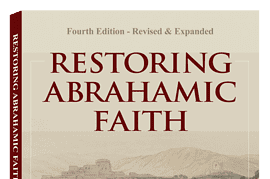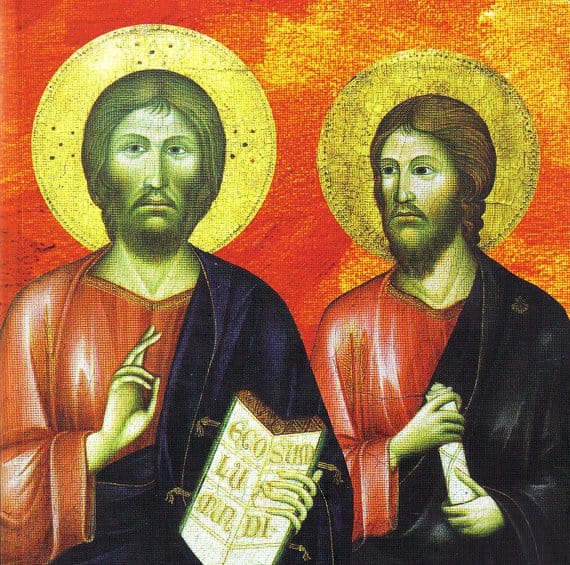The issue of the relationship of Jesus to the “Essenes,” as well as to the the Dead Sea Scrolls, whether Essene or otherwise, is central to our attempts to view Jesus in his historical contexts. In other words, we are essentially asking, in our historical Quest–“what kind of a Jew was Jesus?” We know that James the brother of Jesus assumed the leadership of the original Jerusalem-based Jewish followers of Jesus. Even Paul acknowledged the status of James and at least gave lip service to his authority. What this “Jesus” movement was called or just how it fit into the broader spectrum of Jewish groups and movements of the late 2nd Temple period is a complex issue.
Josephus regularly reports three main sects or schools of Judaism: Pharisees, Sadducees, and Essenes, (War 2: 119; Antiquities 13:171; 18:11). In one passage he mentions a “fourth” philosophy that he does not label but associates with Judas the Galilean, and treats as a kind of “subset” of the Pharisees (Antiquities 18:23). Elsewhere he seems to refer to this movement as the “Zealots,” which seems to be a rather loose designation for those who participated in the 1st Revolt against Rome (War 2:651; 7:268). He mentions John the Baptist, James the brother of Jesus, and Jesus himself (an a passage that has been heavily interpolated), but he never labels the group or movement/s to which they belonged.
Like the group behind the sectarian writings of the Dead Sea Scrolls, the earliest followers of Jesus, apparently, did not use a dominant self-identifying label but preferred a variety of descriptive terms. Paul’s letters are our earliest sources, dating to the 50s CE, and he never “names” his followers or the movement as a whole, but uses phrases like “the believers” or those “in Christ” (1 Thessalonians 1:7, 2:10; 1 Corinthians 14:22; Romans 16: 3, 7, 9; 1 Thessalonians 4:16).
According to the book of Acts, which comes late in the 1st century, the followers of Jesus were called, or perhaps called themselves, “the Way” (Acts 9:2; 19:9, 23; 24:14, 22). The term “Christian” or “Christians” is mentioned twice, but presented as a newly minted designation, probably coming from outsiders, as the movement spread north to Antioch of Syria (Acts 11:26; 26:28). It is surely surprising for many to realize that the term “Christian” only occurs one other time in the entire New Testament, in one of our latest sources (1 Peter 4:16). This is, however, the name that apparently stuck as it shows up in our earliest Roman sources mentioning the movement, namely Suetonius, Tacitus, Pliny the Younger, Lucian, and Galen (see texts here.). It is a Greek name, not a Hebrew or Aramaic one, but unfortunately the English term veils what was likely the more original connotation of the term, which would translate roughly as something like “Messianist.”
There is, however, a reference in the book of Acts to a Hebrew name for the Jesus movement that might have well been its earliest formal appellation. Paul, on trial before the Roman governer Felix, is referred to as being “the ring leader of the sect of the Nazarenes” (Acts 24:5). Whether this term was used by “outsiders” to label the group, or within the movement itself, is difficult to know. Associated with the term “Nazarenes” is a second Hebrew designation, namely Ebionites, that was also apparently used for the earliest mostly-Jewish followers of Jesus.

This Ebionite/Nazarene movement was made up of mostly Jewish followers of John the Baptizer and later Jesus, who were concentrated in Palestine and surrounding regions and led by “James the Just” (the oldest brother of Jesus), and flourished between the years 30-80 C.E. Non-Jews were certainly part of the mix but the dominant ethos of the group was an adherence to what Paul calls ioudaizein–to live according to Jewish law (Galatians 2:14). They were zealous for the Torah and continued to observe the mitzvot (commandments) as enlightened by their Rabbi and Teacher. The non-Jews in their midst were apparently expected to follow some version of the Noachide Laws (Acts 15: 28-29). The term Ebionite (from Hebrew ‘Evyonim) means “Poor Ones” and was perhaps related to the teachings of Jesus: “Blessed are you Poor Ones, for yours is the Kingdom of God” based on Isaiah 66:2 and other related texts that address a remnant group of faithful ones. I am convinced that Nazarene comes from the Hebrew word Netzer (drawn from Isaiah 11:1) and means “a Branch”—so the Nazarenes were the “Branchites” or followers of the one they believed to be the Branch–that is the Davidic Messiah. It is often confused with a completely different word, Nazirite or Nazir, that refers to individuals, male or female, not a group, who took on a special vow based on Numbers 6. The two terms can sound alike in English are spelled differently in Hebrew.
If I were guessing I would think the designation Nazarene was likely used by outsiders for the group, whereas the term Ebionite was more likely used within the group as a self-description. It seems significant that the Dead Sea community also used this term Ebionite or “Poor Ones” to refer to their own movement (CD 19:9; 1QSb 5:21). This movement, that Josephus and others label as Essene (possibly from ‘Ossim, meaning “Doers of Torah”), who wrote or collected the Dead Sea Scrolls, pioneered certain aspects of this “Way” over 150 years before the birth of Jesus. They were a wilderness (out in the Arava, near the Dead Sea–based on Isaiah 40:3), baptizing (mikveh of repentance as entrance requirement into their fellowship), new covenant, messianic/apocalyptic group. They believed they were the final generation and would live to see the end and the coming of the Messiahs of Aaron and of Israel (the two anointed ones–priest and king). They saw themselves as the remnant core of God’s faithful people—preparing the Way for the return of YHVH’s Glory (Kavod) as set forth in Isaiah 40-66. They too referred to themselves as the Way, the Poor, the Saints, the New Covenanters, Children of Light, and so forth. Perhaps their most common designation was the Yachad–the brotherhood or community, and they referred to themselves as brother and sister. They were bitterly opposed to the corrupt Priests in Jerusalem, to the Herods, and even to the Pharisees whom they saw as compromising with that establishment to get power and influence from the Hellenistic/Roman powers. They had their own developed Halacha (interpretation of Torah), some aspects of which Jesus picks up (ideal of no divorce, not using oaths, etc.). They followed one they called the True Teacher (Teacher of Righteousness) whom most scholars believe lived in the 1st century BCE and was opposed and possibly killed by the Hasmonean King/Priests at the instigation of the Pharisees. John the Baptizer seems to arise out of this context and rekindle the apocalyptic fervor of the movement in the early decades of the first century CE. Jesus joined this movement and it remains our best insight into the conceptual world of an apocalyptic, messianic, movement of this period, akin to the Jesus movement.
The variety of self-designations used by the John/Jesus/James movement, many of which had previously been used by the Essenes, is telling. Indeed, one might call the Jesus movement a further developed messianic “Essenism,” modified through the powerful, prophetic influence of Jesus as Teacher and the leadership of James his brother for nearly 40 years.
Later, when Christianity developed in the 3rd and 4th centuries and gradually lost its Jewish roots and heritage, largely severing its homeland connections, the Gentile, Roman Catholic Church historians began to refer to Ebionites and Nazarenes as two separate groups—and indeed, by the late 2nd century there might have been a split between these mostly Jewish followers of Jesus. The distinction these writers make (and remember, they universally despise these people and call them “Judaizers”), is that the Ebionites reject Paul and the doctrine of the Virgin Birth or “divinity” of Jesus, use only the Hebrew Gospel of Matthew, and are thus more extreme in their Judaism. They describe the Nazarenes more positively as those who accept Paul (with caution) and believe in some aspect of the divinity of Jesus, even possibly the virgin birth, but viewed him as “adopted” as Son of God at his baptism. What we have to keep in mind in reading these accounts from the Church fathers is that they are strongly prejudiced against any form of what they call “Judaizing” among Christians and they share the view that “Christianity” has replaced Judaism entirely overthrowing the Torah for both Gentile and Jew.
I think it best today to use the collective term Ebionite/Nazarene in an attempt to capture the whole of this earliest movement, and it would be useful to revive the term Yachad as a collective designation for the community of the Hasidim/Saints. Ebionite/Nazarene is a good historical designation to refer to those original, 1st century, mostly Jewish, followers of Jesus, gathered around James the brother of Jesus in Jerusalem, who were zealous for the Torah, but saw themselves as part of the New Covenant Way inaugurated by their “True Teacher” Jesus. James is a key and neglected figure in this whole picture (see essays on James). As the blood brother of Jesus, authority and rights of leadership were passed on to him. When he was brutally murdered in 62 CE by the High Priest Ananus (see Josephus, Antiquities 20.197ff), Simeon, a second brother [“cousin” according to Hegesippus] of Jesus took over the leadership of the Jerusalem based movement. Clearly we have the idea here of a blood-line dynasty, and according to the Gospel of Thomas, discovered in 1946 in upper Egypt, this dynastic succession was ordained by Jesus himself who tells his followers who ask him who will lead them when he leaves: “No matter where you are, you are to go to James the Just, for whose sake heaven and earth came into being” (Gospel of Thomas 12, and additional primary texts here). Indeed, when Simeon was crucified by the Emperor Trajan around 106 C.E., one Judas, perhaps an aged third brother of Jesus, or at least a close relative of the bloodline, took over the leadership of the community.
As far as “beliefs” of the Ebionites, the documents of the New Testament, critically evaluated, are our best sources, including some of the fragmentary traditions still embedded in the book of Acts (7:37-53). There are fragments and quotations surviving from their Hebrew Gospel tradition (see see A. F. J. Klijn, Jewish-Christian Gospel Tradition, E. J. Brill, 1992), the so-called Pseudo-Clementine materials, as well as some of the traditions reflected in texts such as the “Hebrew Matthew” preserved by Ibn Shaprut, and now published in a critical edition by George Howard (The Hebrew Gospel of Matthew, Mercer University Press, 1995). Based on what we can reliably put together from these sources we can say the Ebionite or Nazarene movement could be distinguished by the following views:
1) Jesus as a human being with father and mother but designated a “Prophet like Moses,” or “the Anointed of the Spirit,” who will be revealed in power as the “Son of Man coming in the Clouds of heaven,” following his rejection and death (Acts 7:37; Luke 4:18-19; Mark 10:35-45; 13:26-27).
2) Disdain for eating meat and even the Temple slaughter of animals, preferring the ideals of the pre-Flood diet and what they took to be the original ideal of worship (see Genesis 9:1-5; Jeremiah 7:21-22; Isaiah 11:9; 66:1-4). This reflects a general interest in seeking the “Path” reflected in the pre-Sinai revelation, especially the time from Enoch to Noah. For example, divorce was shunned, as violating the Edenic ideal, even though technically it was later allowed by Moses (Mark 10:2-11).
3) Dedication to following the whole Torah, as applicable to Israel and to Gentiles, but through the “easy yoke” or the “Torah of liberty” of their Teacher Jesus, which emphasized the Spirit of the Biblical Prophets in a restoration of the “True Faith,” the Ancient Paths (Jeremiah 6:16; Matthew 11:28-30; James 2:8-13; Matthew 5:17-18; 9:13; 12:7), from which, by and large, they believed the establishment Jewish groups of 2nd Temple times had departed.
4) Rejection of the “doctrines and traditions” of men, which they believed had been added to the pure Torah of Moses, including scribal alterations of the texts of Scripture (Jeremiah 8:8).
Generally, the movement came to have a very negative view of Paul as an “apostate from the Torah,” though it is possible that in the 2nd and 3rd centuries there were branches of the Nazarenes who were more tolerant of Paul as the “apostle to the Gentiles,” but who as Jews, nonetheless, insisted on Torah observance.
For much more on the whole “underbelly” of the original Jesus movement led by James the brother of Jesus, its relationship with the Dead Sea Scroll sect, and the Ebionites and their subsequent history, see Robert Eisenman, James the Brother of Jesus (Penguin, 1998). There is a new abridged edition of this work as well here, but I recommend the original for serious students of early Christianity. On “Jewish Christianity” more generally, see H-J Schoeps, Jewish Christianity (Philadelphia: Fortress Press, 1969), out of print but still useful for students as a general introduction. For a modern interpretation of the Ebionite ideals, reflecting the peaceful ideas of vegetarianism and non-violence, see Keith Akers, The Lost Religion of Jesus: Simple Living and Non-Violence in Early Christianity (Lantern Book, 2000). Finally, there is an active “Ebionite” movement today, that seeks to revive and reflect these ancient perspectives, see the web site: ebionite.org.








Comments are closed.